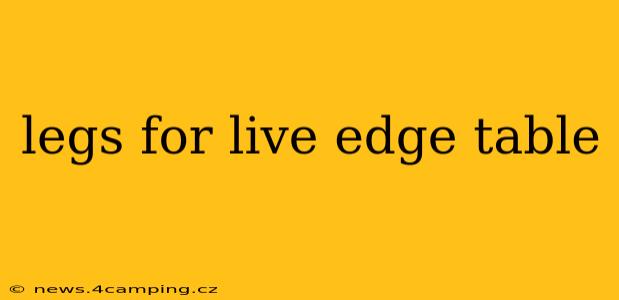Live edge tables, with their stunning natural beauty, are a focal point in any home. But the raw, organic nature of the tabletop requires careful consideration when selecting the right legs. Choosing the wrong legs can detract from the table's beauty or even compromise its stability. This guide will explore various leg styles, materials, and considerations to help you find the perfect support for your live edge masterpiece.
What are the Different Types of Legs for Live Edge Tables?
The beauty of live edge tables lies in their individuality, and the legs should complement this uniqueness. Several styles offer distinct aesthetics and functionalities:
-
Hairpin Legs: These sleek, minimalist legs are a popular choice for their affordability and modern aesthetic. They work well with both rustic and contemporary styles, offering a clean contrast to the organic tabletop. They are usually made from metal (steel or iron) and come in various heights and finishes.
-
Pedestal Legs: A single, central pedestal leg creates a clean, uncluttered look, perfect for showcasing the table's natural beauty without distraction. These legs often feature a wider base for increased stability, especially important with larger, heavier live edge slabs.
-
Trestle Legs: These offer a more traditional, rustic appearance. They are typically made from wood and consist of a horizontal beam supported by two vertical legs. Trestle legs can be quite substantial, adding a sense of strength and stability to the table.
-
Tapered Legs: These offer a classic and elegant look. The gradual narrowing from top to bottom provides a sense of visual lightness, while still offering robust support. They are available in various materials, including wood and metal.
-
X-Base Legs: Similar to trestle legs in their sturdy build, X-base legs create a striking visual effect with their crisscrossing design. These provide exceptional stability and are suitable for larger and heavier tabletops.
What Materials are Best for Live Edge Table Legs?
The choice of material significantly impacts the overall aesthetic and durability of your table.
-
Metal: Steel and iron are popular choices for their strength, durability, and modern feel. They are often powder-coated for added protection and a variety of finishes.
-
Wood: Wood legs complement the natural aesthetic of the live edge tabletop beautifully. Hardwoods like oak, walnut, and maple are durable choices. Consider matching the wood type to the tabletop for a cohesive look or selecting a contrasting wood for a more dramatic effect.
-
Combination Materials: Blending materials, such as a wooden tabletop with metal legs, can create an interesting contrast and highlight the unique aspects of both.
How Do I Choose the Right Height for My Live Edge Table Legs?
The height of your table legs is crucial for comfort and functionality. Standard dining table heights range from 28 to 30 inches. Consider the intended use of the table – a coffee table will be much shorter than a dining table. Measure your live edge slab carefully to determine the appropriate leg height to achieve your desired final table height.
What is the Best Way to Attach Legs to a Live Edge Tabletop?
Securing the legs properly is essential for the table's stability and longevity. Consult a professional if you lack woodworking experience. Several methods exist, including:
-
Bolting: This is a strong and reliable method, especially for heavier tabletops and sturdy legs.
-
Screwing: Screws provide a less intrusive option for attaching legs but may not be as strong as bolts.
-
Using specialized brackets or joinery: These offer clean and aesthetically pleasing solutions, but may require more advanced woodworking skills.
How Much Weight Can Different Table Leg Materials Support?
The weight capacity of your table legs depends on several factors, including the material, design, and dimensions of the legs, as well as the weight and size of the tabletop. Metal legs generally support heavier weights than wooden legs. Always consider the size and weight of your live edge slab when choosing legs to ensure adequate support and stability.
Choosing the right legs for your live edge table is a critical step in creating a stunning and functional piece of furniture. By considering the style, material, height, and attachment method, you can create a unique table that will be a treasured centerpiece in your home for years to come. Remember to always prioritize stability and safety when selecting and attaching the legs.
